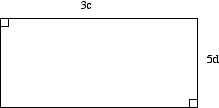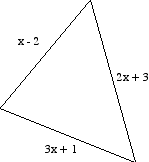1. Substitute the values given in the following formulae to find the value of the unknown variable:
|
a. |
P = 2x + 2y |
Find P when x = 3 mm and y = 4 mm. This is the formula for the perimeter of a rectangle. |
|
b. |
V = lwh |
Find V when l = 2 m, w = 3 m and h = 6 m. This is the formula for the volume of a cuboid. Answer is in m3 |
|
c. |
A = 0.5h(a + b) |
Find A when h = 4 cm, a = 3.5 cm and b = 2.5 cm This is the formula for the area of a trapezium. Answer is in cm2. |
|
d. |
v = d⁄t |
Find v when d (distance) = 100 metres and t (time) = 10 seconds This is a formula for velocity. Answer is in metres per second. |
|
e.
|
C = 0.5F − 15 |
Find C when F = 77°. This is an approximate formula for changing degrees fahrenheit to degrees centigrade. Answer is in degrees centigrade. |
|
f.
|
P = V2⁄R |
Find P when V (voltage) = 12 volts and R (resistance) = 1000 ohms This is a formula for power. Answer is in watts. |
|
g.
|
F = mg |
Find F when m (mass) = 12 kg and g (accelaration due to gravity) = 10 m/s2. This is a formula for force. Answer is in Newtons. |
|
h.
|
C = 5⁄9 × (F − 32) |
Find C when F = 77° This is an precise formula for changing degrees fahrenheit to centigrade. Answer is in degrees centigrade. |
|
i.
|
I = 180 (n − 2) |
Find I when n = 10. This is the formula for the sum of the interior angles of a polygon. |
|
j. |
C = 2π r |
Find C when π = 3.14 and r = 4.5 cm This is a formula for the circumference of a circle. Answer is in cm. |
2. Construct a formula for the area and perimeter of the following rectangle:

3. Make a formula for the perimeter of the triangle and find the perimeter when x = 2. All measurements in centimetres.

4. Make a formula for the size of angle P in this triangle. Remember that the angles in a triangle add up to 180°
Find the size of each angle when x = 50.
